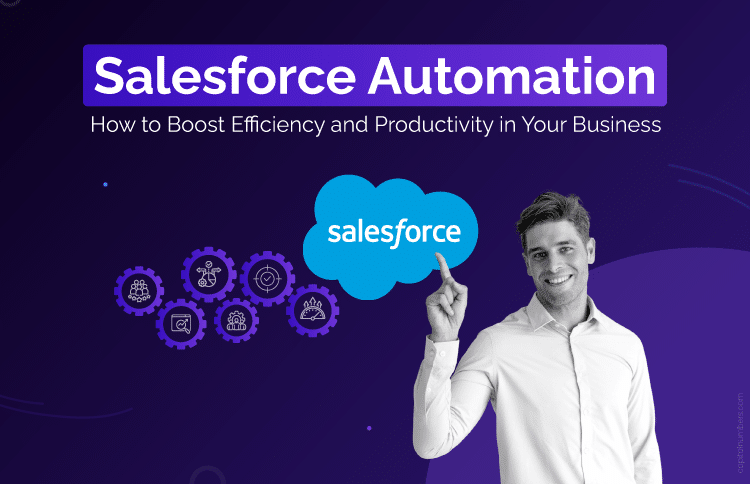Salesforce Automation: How to Boost Efficiency and Productivity in Your Business
Table of Contents
In today’s competitive business landscape, efficiency and speed define success. Organizations across industries are adopting Salesforce not just as CRM, but as a central automation engine that drives productivity and smarter decision-making.
With Salesforce’s powerful automation capabilities, businesses can streamline repetitive tasks, improve data accuracy, and allow employees to focus on what truly matters – innovation, strategy, and customer relationships.
This article explores how automation empowers businesses to operate more efficiently and productively. We’ll discuss key automation tools, practical use cases, and best practices to get the most out of your Salesforce investment.
What Is Salesforce Automation and Why It Matters
Salesforce automation refers to using tools and workflows within the platform to perform repetitive or manual tasks automatically – with little or no human intervention. From assigning leads to sending email notifications, automation ensures that processes run seamlessly in the background.
Why Salesforce Automation Is Critical for Modern Businesses
Without automation, teams often face:
- Data entry errors due to manual updates
- Delayed follow-ups with leads or customers
- Inefficient approvals that slow down business operations
- Inconsistent processes across departments
Automation solves these problems by enforcing standardized workflows, reducing human error, and ensuring that the right actions happen at the right time.
Top Salesforce Automation Tools You Should Know

Salesforce provides a rich suite of automation tools that can handle everything from simple notifications to complex, multi-step processes.
1. Workflow Rules (Legacy Automation)
Workflow Rules are one of the oldest automation tools in Salesforce. They allow users to automate basic tasks like sending email alerts, updating fields, or creating tasks when certain criteria are met.
While powerful, Workflow Rules are being phased out in favor of more modern automation tools like Flow Builder.
2. Process Builder
Process Builder introduced a visual, drag-and-drop interface that made automation easier for administrators. You can define “if/then” logic to automate updates across related records.
However, Salesforce now recommends migrating all Process Builders to Flows, as the latter provides more flexibility and efficiency.
3. Flow Builder
Flow Builder is the heart of modern Salesforce automation. It’s a powerful tool that can automate complex business processes without writing a single line of code.
Flows can:
- Create, update, or delete records automatically
- Send customized notifications
- Call Apex classes for advanced logic
- Guide users through interactive screens (Screen Flows)
Flow is the future of automation in Salesforce – combining the best of Workflow Rules, Process Builder, and code-based logic into one unified tool.
4. Approval Processes
Approval Processes in Salesforce streamline the decision-making chain. Whether it’s discount approvals, budget requests, or expense claims, approvals can be automatically routed to the right person based on defined rules.
This eliminates bottlenecks and ensures decisions are made faster.
5. Einstein Automate
For organizations looking to take automation to the next level, 3instein Automate combines AI with automation. It uses Salesforce Flow, MuleSoft Composer, and Einstein Bots to connect systems, automate workflows across apps, and deliver intelligent recommendations.
Imagine automatically sending follow-up emails to leads predicted to convert – that’s the power of AI-driven automation.
Salesforce Automation Use Cases: How Businesses Improve Productivity
To understand how automation improves productivity, let’s explore a few real-world use cases:
Lead Assignment Automation
Manually assigning leads often results in delays or misallocation. With automation, Salesforce can:
- Assign leads to the right sales rep based on territory or product interest
- Notify reps instantly when a new lead arrives
- Update lead status automatically once it’s converted
This ensures no opportunity slips through the cracks.
Automated Opportunity Follow-Ups
Sales reps can set up automated reminders for key opportunity stages – such as following up on proposals or contract renewals.
Flow Builder can trigger emails or tasks based on the opportunity stage or inactivity duration, keeping the sales cycle moving efficiently.
Customer Onboarding Automation
Once a deal is closed, onboarding can be automated using Flows and Approval Processes:
- Automatically create onboarding tasks for different departments
- Send welcome emails to customers
- Assign a success manager
This creates a seamless customer experience while freeing up your team to focus on engagement.
Case Management Automation
Support teams can benefit greatly from automation. Cases can be:
- Auto-assigned based on product type or priority
- Escalated if unresolved within a set time frame
- Linked to a knowledge base article automatically for faster resolution
This boosts customer satisfaction and reduces manual effort.
Automated Invoicing and Reminders
Finance teams can automate invoice generation and send payment reminders based on due dates. This ensures timely collections and improves cash flow management.
5 Key Benefits of Salesforce Automation for Business Growth
- Increased Productivity: Automation eliminates time-consuming manual tasks, allowing teams to focus on strategic initiatives rather than repetitive work.
- Enhanced Accuracy: By minimizing human intervention, automation reduces data entry errors, ensuring clean and reliable CRM data.
- Faster Decision-Making: With automated notifications and approvals, decisions move through the organization quickly, improving overall responsiveness.
- Consistency Across Teams: Automation enforces standardized processes, ensuring everyone follows the same workflow – whether it’s sales, service, or marketing.
- Improved Customer Experience: Faster responses, timely follow-ups, and personalized communication result in happier, more loyal customers.
Best Practices for Implementing Salesforce Automation Successfully
- Start Simple: Begin with straightforward use cases like lead assignment or email notifications before tackling complex, multi-step automations.
- Document Your Processes: Clearly define business processes before automating them. This helps avoid confusion and ensures your automation aligns with organizational goals.
- Thorough Test: Always test Flows in a sandbox environment before deploying to production. Testing helps identify logic errors or unexpected outcomes.
- Monitor and Optimize: Use the Flow Error Logs and Debug Mode to monitor automation performance and optimize over time. Regular audits ensure your automations stay relevant as business needs evolve.
- Keep User Experience in Mind: Automation should make users’ lives easier – not more complicated. Always design with usability in mind, using screen flows or guided steps where necessary.
The Future of Salesforce Automation
Salesforce continues to evolve its automation capabilities with Einstein Copilot ,AI-powered Flow recommendations,and tighter integrations with third-party systems via MuleSoft . The focus is shifting from rule-based automation to intelligent automation – where AI predicts, recommends, and even takes actions proactively.
In the coming years, we can expect Salesforce automation to become:
This means businesses that embrace automation today will gain a competitive edge in agility and efficiency tomorrow.
You May Also Read: How Salesforce Powers Digital Transformation and Fuels Business Growth
You May Also Read: You May Also Read: How Salesforce Powers Digital Transformation and Fuels Business Growth
Conclusion
Salesforce automation is no longer a luxury – it’s a necessity for businesses aiming to scale efficiently and deliver superior customer experiences. By leveraging tools like Flow Builder, Approval Processes, and Einstein Automate, organizations can eliminate manual work, ensure data accuracy, and improve collaboration across teams.
Ultimately, automation empowers your workforce to do what humans do best – think creatively, solve problems, and build meaningful relationships – while Salesforce takes care of the rest.
So, if your goal is to improve efficiency, boost productivity, and create a smarter CRM ecosystem, investing in Salesforce development services automation is the key that unlocks it all.
Salesforce Automation Key Takeaways
- Salesforce automation reduces manual tasks and human errors.
- Flow Builder is now the go-to tool for creating scalable automations.
- Automation improves productivity, accuracy, and customer satisfaction.
- Start small, test thoroughly, and evolve toward intelligent automation.

















